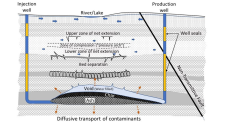
Quintessa employees have co-authored a paper on a flexible risk assessment methodology for geoenergy technologies with Cardiff University's Geoenvironmental Research Centre.
Renato Zagorscak, Richard Metcalfe, Laura Limer, Alex Bond and Sarah Watson of Quintessa and Prof. Hywel Thomas and Ni An of the Geoenvironmental Research Centre contributed to the paper, which has recently been published in the Journal of Cleaner Production, with an impact factor of 11.07. The methodology set out is based on an established approach used for radioactive waste repositories. The associated work contributed to the FLEXIS project, an interdisciplinary research project on flexible integrated energy systems led by Cardiff University, and supported the delivery of the project’s Sustainable Earth Energy (SEREN 2020) theme led by the Geoenvironmental Research Centre.
The transition to a low-carbon energy economy will take several decades and in the interim it may be necessary to use transitional technologies in some parts of the world. A range of geoenergy technologies are currently being considered as possible solutions for reducing emissions of CO2 and other gases to atmosphere and at the same time, provide sustainable sources of low-carbon energy. These technologies require understanding of the geological and engineering controls and risks related to injection, extraction or interaction with fluids, for their responsible and safe utilisation to achieve a low-carbon future.
As a part the portfolio of geoenergy technologies, the FLEXIS project aimed to make significant advances beyond “state-of-the-art” and evaluate the potential use of deep-lying subsurface deposits for the development of underground coal gasification (UCG) in a safe and environmentally responsible way. Quintessa’s extensive experience in undertaking risk assessments and performance assessments for complex systems based on the application of systems-level mathematical models was instrumental in developing a flexible risk assessment methodology that can be applied at any stage in an UCG project, between initial planning and final site abandonment, using an established and internationally recognised structured approach.
Central to the approach was the analysis of scenarios, which represents a “source-pathway-receptor” combination and its evolution. In this work, a Reference Scenario and several Alternative Scenarios were developed and analysed using a numerical model developed in Quintessa’s compartment modelling software AMBER. An illustrative application of the methodology to a hypothetical site demonstrated that risks of groundwater contamination should be very low if the site is developed and operated appropriately. The outcomes from applying the numerical model are intended to demonstrate how the methodology and the numerical model can be readily adapted to different sites and different geoenergy technologies seeking to utilise the subsurface in a sustainable manner. The systems models that Quintessa developed can be used to quantify consequences under different conditions, which is invaluable in deciding how to improve management practices.